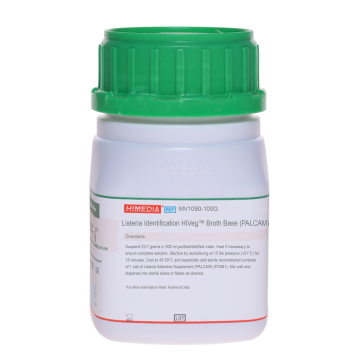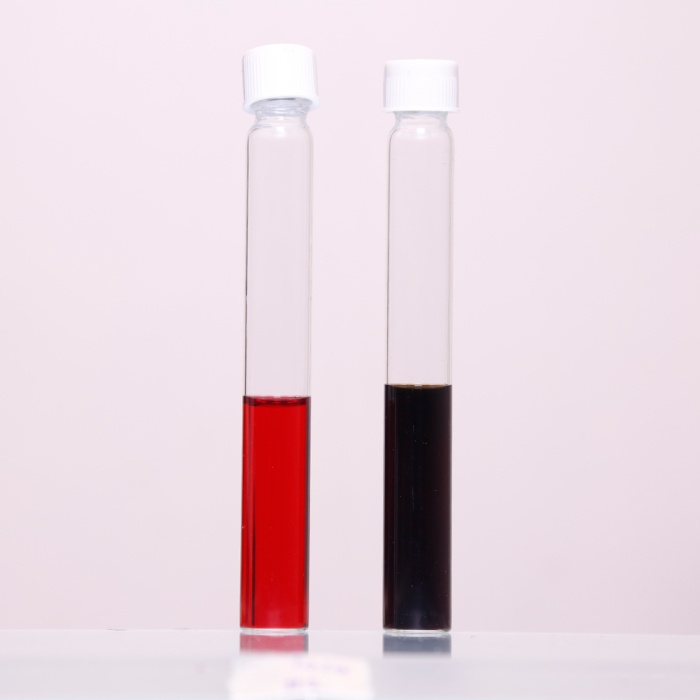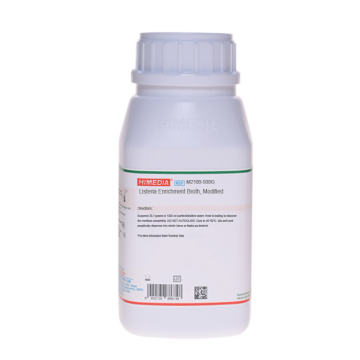 Your enquiry has been submitted
Your enquiry has been submitted
Listeria Identification Broth Base (PALCAM)
Intended use
Listeria Identification Broth Base (PALCAM) with added supplement is recommended for selective enrichment and identification of Listeria species from clinical and non-clinical samples.
Composition
| Ingredients | Gms/Litre |
|---|---|
| Peptone | 23.000 |
| Yeast extract | 5.000 |
| Lithium chloride | 10.000 |
| Esculin | 0.800 |
| Ammonium ferric citrate | 0.500 |
| D-Mannitol | 5.000 |
| Soya lecithin | 1.000 |
| Polysorbate 80 | 2.000 |
| Phenol red | 0.080 |
| Final pH (at 25°C) | 7.4±0.2 |
Formula adjusted, standardized to suit performance parameters
Directions
Suspend 23.69 grams in 500 ml purified / distilled water. Heat if necessary to dissolve the medium completely. Sterilize by autoclaving at 15 lbs pressure (121°C) for 15 minutes. Cool to 45-50°C and aseptically add sterile reconstituted contents of 1 vial of Listeria Selective Supplement (PALCAM) (FD061). Mix well and dispense into sterile test tubes or flasks as desired.
Principle And Interpretation
The heightened awareness and concern surrounding the presence of Listeria monocytogenes in food has resulted in the development of many media for its isolation (2). Listeria Identification Broth also known as Polymyxin-Acriflavin-Lithium chloride-Ceftazidime-Aesculin-Mannitol (PALCAM) Broth is prepared as described by van Netten et al (7) for selective enrichment of Listeria species.
Peptone and yeast extract provide nitrogen and carbon compounds, long chain amino acids and other growth nutrients. High amount of lithium chloride and added selective supplement (FD061) (5) containing polymyxin B, acriflavin hydrochloride and ceftazidime inhibit accompanying microflora and allow the growth of Listeria species. Soya lecithin has similar properties as that of egg yolk; hence additional supplementation of egg yolk emulsion is not required. After incubation at 30°C for 24-48 hours, approximately 0.1 ml of the broth is streaked on Listeria selective agars such as Listeria Identification Agar (PALCAM) (M1064) or Listeria Oxford Agar (M1145). The combination of mannitol and phenol red helps the detection of mannitol fermentation while esculin and ammonium ferric citrate together help in detection of esculin hydrolysis.
L. monocytogenes hydrolyses esculin resulting in the formation of black coloured medium. L. monocytogenes does not ferment mannitol, therefore its differentiation from contaminants such as Enterococci and Staphylococci can be made as the later will ferment mannitol and produce a colour change from red to yellow. Incubation under microaerophilic conditions serves to inhibit strict aerobes such as Bacillus and Pseudomonas species. Techniques for the isolation of L. monocytogenes will depend on the material under test. It is usual for the test sample to be first inoculated into an enrichment broth to allow multiplication before isolation and identification. Depending on the types of samples used, the appropriate method and selective enrichment broth should be used.
Type of specimen
Clinical samples - blood, Food and dairy samples.
Specimen Collection and Handling
For clinical samples follow appropriate techniques for handling specimens as per established guidelines (3,4).
For food samples, follow appropriate techniques for sample collection and processing as per guidelines (6).
For water samples, follow appropriate techniques for sample collection, processing as per guidelines and local standards.(1)
After use, contaminated materials must be sterilized by autoclaving before discarding.
Warning and Precautions
In Vitro diagnostic Use. Read the label before opening the container. The media should be handled by trained personnel only. Wear protective gloves/protective clothing/eye protection/ face protection. Follow good microbiological lab practices while handling specimens and culture. Standard precautions as per established guidelines should be followed while handling clinical specimens. Safety guidelines may be referred in individual safety data.
Limitations :
- Due to nutritional variation, some strains may show poor growth.
Performance and Evaluation
Performance of the medium is expected when used as per the direction on the label within the expiry period when stored at recommended temperature.
Quality Control
Appearance Light yellow to pink homogeneous free flowing powder
Colour and Clarity of prepared medium Red coloured, clear solution without any precipitate
Reaction Reaction of 4.74% w/v aqueous solution at 25°C. pH : 7.4±0.2
pH 7.20-7.60
Cultural Response
Cultural characteristics observed with added Listeria Selective Supplement (PALCAM) (FD061), after an incubation at 30°C for 24-48 hours.
| Organism | Inoculum (CFU) | Growth | Colour of medium |
|---|---|---|---|
| Enterococcus faecalis ATCC 29212 (00087*) | >=104 | inhibited | |
| Listeria monocytogenes ATCC 19118 | 50-100 | good | black |
| Micrococcus luteus ATCC 10240 | >=104 | inhibited | |
| Staphylococcus aureus ATCC 25923 | >=104 | inhibited |
Storage and Shelf Life
Store between 10-30°C in a tightly closed container and the prepared medium at 2-8°C. Use before expiry date on the label. On opening, product should be properly stored dry, after tightly capping the bottle in order to prevent lump formation due to the hygroscopic nature of the product. Improper storage of the product may lead to lump formation. Store in dry ventilated area protected from extremes of temperature and sources of ignition Seal the container tightly after use.
Product performance is best if used within stated expiry period.
Disposal
User must ensure safe disposal by autoclaving and/or incineration of used or unusable preparations of this product. Follow established laboratory procedures in disposing of infectious materials and material that comes into contact with clinical sample must be decontaminated and disposed of in accordance with current laboratory techniques (3,4).
Reference
- Baird R.B., Eaton A.D., and Rice E.W., (Eds.), 2015, Standard Methods for the Examination of Water and Wastewater, 23rd ed., APHA, Washington, D.C.
- Farber J. M. and Peterkin P., 1991, Microbiol. Rev. 55: 476-511
- Isenberg, H.D. Clinical Microbiology Procedures Handbook. 2nd Edition.
- Jorgensen, J.H., Pfaller, M.A., Carroll, K.C., Funke, G., Landry, M.L., Richter, S.S and Warnock., D.W. (2015) Manual of Clinical Microbiology, 11th Edition. Vol. 1.
- Lund A. M., 1991, J. Food Prot., 54:602.
- Salfinger Y., and Tortorello M.L., 2015, Compendium of Methods for the Microbiological Examination of Foods, 5th Ed., American Public Health Association, Washington, D.C.
- Van Netten P. et al, 1989, Int. J. Food Microbiol., 8:299.
| Product Name | Listeria Identification Broth Base (PALCAM) |
|---|---|
| SKU | M1090 |
| Product Type | Regular |
| Physical Form | Powder |
| Origin | Animal |
| Packaging type | HDPE |
| References | 1. Van Netten P. et al, 1989, Int. J. Food Microbiol., 8:299. |
| Customized Product Available | No |











